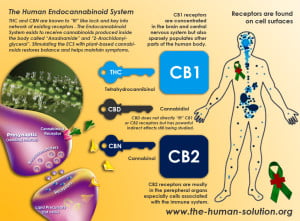Doug Michael
Multiple Sclerosis is a progressive disease that affects approximately 2.3 million people worldwide. Little is known about the causal factors of this illness and there is no known cure. MS is considered an immune-mediated disease in which the immune system mistakenly attacks the central nervous system (CNS) which consists of the brain, spinal cord and optic nerves. Specifically, the immune system attacks the myelin coating of the nerves in the CNS thereby causing lesions to develop which manifests as numerous, often very debilitating symptoms.
MS usually appears in individuals between the ages of 15 and 50 but it can appear at any time and there are some reported cases of pediatric MS. Unfortunately, there is only speculation as to the etiology of this incapacitating illness. Some theories suggest a viral connection to MS, genetic factors and even a connection to vitamin D deficiency. All people with MS have low levels of vitamin D and it is conclusive that vitamin D plays a significant role in regulating the immune system.
From the National MS Society’s website, we read:
“Since initial exposure to numerous viruses, bacteria and other microbes occurs during childhood, and since viruses are well recognized as causes of demyelination and inflammation, it is possible that a virus or other infectious agent is the triggering factor in MS. More than a dozen viruses and bacteria, including measles, canine distemper, human herpes virus-6, Epstein-Barr, and Chlamydia pneumonia have been or are being investigated to determine if they are involved in the development of MS, but none have been definitively proven to trigger MS.”[i]
There are four main types of Multiple Sclerosis and the disease seems to progress in stages. The primary variations are as follows:
- Relapsing-Remitting MS (RRMS). This is the most common form of multiple sclerosis. About 85% of people with MS are initially diagnosed with RRMS. People with RRMS have temporary periods called relapses, flare-ups or exacerbations, when new symptoms appear.[ii]
- Secondary-Progressive MS (SPMS). In SPMS, symptoms worsen more steadily over time, with or without the occurrence of relapses and remissions. Most people who are diagnosed with RRMS will transition to SPMS at some point.[iii]
- Primary-Progressive MS (PPMS). This type of MS is not very common, occurring in about 10% of people with MS. PPMS is characterized by slowly worsening symptoms from the beginning, with no relapses or remissions.[iv]
- Progressive-Relapsing MS (PRMS). A rare form of MS (5%), PRMS is characterized by a steadily worsening disease state from the beginning, with acute relapses but no remissions, with or without recovery.[v]
Due to the fact that the central nervous system is under attack in MS patients, this illness presents itself in a myriad of severe, often extremely debilitating symptoms. Among them are:
- Numbness
- Coordination, balance and gait problems
- Difficulty in controlling bladder functions
- Fatigue
- Spasticity
- Vision problems including partial or total blindness
- Extreme pain often related to nerve damage
- Vertigo
- Sexual dysfunction
- Depression
- Cognitive dysfunction and difficulties with basic motor functions
- Emotional changes
- Speech and vocal disorders
- Uncontrollable tics and spasms[vi]
This list is by no means complete but these are some of the main symptoms that present in people afflicted with Multiple Sclerosis. As can be easily ascertained, this illness can have a dramatic impact upon a person, severely undermining their quality of life.
It is generally acknowledged that stress can play a major role in the flare-up of MS symptoms. In late 2010, following the death of my younger brother and amidst other personal problems, I awoke one morning with the left side of my face completely paralyzed. I thought I had suffered a mini stroke. Thus began a battery of tests, trips to neurologists and several different diagnoses to determine what was wrong with me.
The first diagnosis was of Lyme Disease, offered by the emergency room doctor of a local hospital. I was then referred to a neurologist who thought it may be Hodgkin’s Lymphoma. Needless to say, I was absolutely freaking out as the doctors tried to come up with a diagnosis. It was my primary doctor that discovered what looked like a lesion on the right side of my brain which showed up on the MRI film. She phoned me and suggested that I may have MS. I must confess, I knew very little about MS, except that many people are bound to wheelchairs because of it and I must say, my heart sank as I fell into a deep depression. There was still no definitive diagnosis at this point, and usually, there needs to be two episodes before a definite diagnosis is made.
About five months later, a second episode occurred and presented as optic neuritis, severe inflammation of the optic nerve. I awoke with extreme pain in my right eye and was almost completely blind in that eye. It hurt terribly and I remember the pain throbbing from just behind my eye and all the way into the center of my head; it was terrible. More MRI scanning, CAT scans and trips to the neurologist followed. I went from perfect 20/20 vision to 20/200 vision; I was legally blind and in immense pain. Eventually, the optic neuritis subsided and most of my vision returned; however, I did lose about 10% of my vision in the right eye.
The diagnosis was finally made and I was told that I was suffering with Multiple Sclerosis. It was suggested by the neurologist that I begin a regiment of treatment with an injectable, disease-modifying medicine called Copaxone, the commercial name for a drug called glatiramer acetate.[vii]
I agreed to the treatment and began injecting Copaxone on a daily basis as per the recommended prescription. Immediately, I experienced negative reactions to this medication. Since it must be injected on a daily basis, the injection sites must be rotated so as to minimize damage to the skin and fat cells. I followed all of the instructions and noticed that whenever I injected the medicine, painful, itchy cysts would appear at the injection sites and they would persist for days, sometimes even weeks. The medicine burned and every day, each injection felt like the equivalent of a bee sting.
The deciding factor in my decision to discontinue the use of this medication was when I injected it one day and suffered a severe, allergic reaction. I became flush, my heart raced and my throat closed up. The injection site stung intensely and I became extremely light headed. The manufacturer claims that this is a relatively “normal” side effect. That day ended a six-month regiment of injection treatment and sparked an intensive, year-long study into alternative treatments for Multiple Sclerosis.
I looked into a plethora of alternative treatments and tried many of them, including: hydrogen peroxide treatment;[viii] holistic chelation, with the use of a mineral called Micronized Zeolite; dietary changes; ingestion of high doses of vitamin D3; multivitamin supplementation; an off market drug called Low Dose Naltrexone (LDN), which I compounded myself; ingestion of food grade diatomaceous earth; and I even spent two years teaching myself how to make perhaps the most potent botanical medicine in the world, an ancient, shamanic, medicinal brew called Ayahuasca. I was determined to find a way to deal with the MS symptoms and to be honest, many of the doctors had been less than helpful. Never once was it even mentioned that I was vitamin D deficient. None of the neurologists I met with ever suggested to eliminate gluten[ix] or offered the idea of a detox treatment. Pharmaceutical drugs however, are in abundant supply. “Take these injections daily and I’ll see you back in six months,” seemed to be the general attitude.
At least the second neurologist I saw was more open minded and actually prescribed me LDN, so I no longer had to purchase it from the internet and compound it down to the correct dose by myself. There seems to be some promise with this drug although it is not FDA approved, so it is hard to find a doctor who will prescribe it and most insurance policies will not cover the cost. Thankfully, it is very cheap and the out of pocket cost to me was only around $40.00 per month.
Compare that to the cost of Copaxone, which is roughly between $3,200 and $5,000 per month! When I began taking it, the cost was $3,050 per month and apparently, when taking into consideration the rapid and astronomical rise in cost, three grand was the bargain price.
Inevitably, after extensive research, I came across tons of research and testimonials of MS patients that were successfully treating their MS symptoms with the use of Cannabis. I must admit, I had used Cannabis before for recreational purposes, but at the time that I was looking into alternative treatments, I hadn’t used it in years. The number of people that reported symptom relief through the use of this plant and the published, scientific studies piqued my interest and I decided that it was worth a try to get relief from the horrors I was experiencing from this awful illness.
With MS, often patients will experience mini flare-ups between full blown exacerbations. I have not had an extreme attack in well over three years and I attribute that to vitamin D3 and to the use of Cannabis, because these are the two things I have been very consistent with. The detox treatments and alternative therapies I tried seemed to help also. In the beginning, my attacks were about six months apart with flare-ups in between but I seem to have been able to slow the progression. Even the neurologist was surprised that I hadn’t had a full blown attack in over three years. I have however, suffered many flare-ups.
What I’ve experienced mostly has been numbness in my left arm, cognitive difficulties, depression, slurred speech, pain in the optic nerve, severe fatigue, brain fog, stiffness in the muscles, cramping, eyeball fluttering, uncontrollable tics, loss of concentration and on some occasions, emotional imbalance. One of the most annoying symptoms, which occurs frequently, is severe cramping in my feet. My toes curl up under my feet in uncontrollable spasms; it is very painful and seems to happen at the most inopportune moments. For me, Cannabis has helped immensely for most of these symptoms. It helps to ease the pain in my optic nerve and relieves muscle stiffness. It reduces depression and eases fatigue. I began my treatments with smoking Cannabis but switched to vaporizing as it seems to be far more beneficial. Since combustion is not being utilized to heat the plant, there is no tar or heavy feeling on the lungs. The symptom relief I get from vaporizing is amazing. I also tried non-psychoactive Cannabis oil and that seemed to offer the most relief with absolutely no side effects.
A fairly recent scientific discovery has uncovered the existence of the endocannabinoid system within the human body, which can be defined thusly:
“The endogenous cannabinoid system, named after the plant that led to its discovery, is perhaps the most important physiologic system involved in establishing and maintaining human health. Endocannabinoids and their receptors are found throughout the body: in the brain, organs, connective tissues, glands, and immune cells. In each tissue, the cannabinoid system performs different tasks, but the goal is always the same: homeostasis, the maintenance of a stable internal environment despite fluctuations in the external environment.”[x]

It is known that there are at least 80 different cannabinoids contained within the Cannabis plant, many of which are showing great promise in the relief of a multitude of various illnesses. With regards to Multiple Sclerosis, one particular cannabinoid known as Canibidiol (CBD) has been shown to exhibit extraordinary, anti-inflammatory properties and the interest of the use of this compound in the treatment of MS has skyrocketed within the scientific community. CBD and other cannabinoids support the body’s endocannabinoid system and provide homeostasis to the body, in other words, they bring the physiology of the body into balance. In fact, a recent published report in the Journal of Neuroimmune Pharmacology, has shown that Cannabis, particularly CBD, exhibits amazing anti-inflammatory properties and can be extremely beneficial in slowing the progression of MS.[xi] I personally don’t need to wait for science to confirm what I already know to be true. When I’m experiencing flare-ups, vaporization of a small amount of Cannabis or the ingestion of a small amount of extracted oil from the plant, provides amazing relief.
One of the main problems is the stigma surrounding the use of the Cannabis plant. I’ve had people, some of which who were close to me, basically laugh at the idea that my use of this plant was providing relief of a multitude of symptoms. These are the types of people whose minds remain closed to even the strongest argument, who would never bother to read anything that may challenge their conditioned beliefs and who appear to be committed to not understanding, and merely defending what they think they know.
The fact that so many suffer from this incurable, debilitating illness and obtain relief from the use of the Cannabis plant should be enough, and I certainly don’t feel the need to justify my seeking of relief from a natural, plant medicine, because of archaic laws and willfully embraced ignorance. The oil I use is not even psychoactive and my feeling is that it is my natural right, as a human being, to use this medicine to treat this debilitating condition, despite outdated and unfair laws or the blather spouted by people who simply do not know what they are talking about.
I wish I had a dollar for every time that I heard some nonsensical statement such as: “well you look ok,” or: “my cousin has MS and she’s just fine.” First of all, a person suffering with MS is not “just fine,” and I’m no neurologist, but I’m fairly certain that brain and spinal cord lesions do not show on the outside. Dealing with MS is extremely challenging, even if it hasn’t yet progressed to the point where the symptoms are fully visible.
In my research, I came across a video of a man suffering extremely violent shaking episodes and uncontrollable spasms. After just a few tokes of Cannabis his shaking, speech and muscle spasms were markedly improved.[xii] I have personally experienced this as well. I thought that if this natural plant could provide that kind of immediate relief, that it was worth a try and I’m glad that I incorporated this medicine into my regiment of alternative treatments. For those suffering with MS, remember, the most promising compound appears to be CBD, which is a non-psychoactive Cannabinoid. Again I will reiterate; the oil that I use does not cause a high and there are absolutely no side effects. There are many in the fields of science, chemistry and medicine that will still claim that Cannabis has no medicinal value; usually they are on the payroll of some pharmaceutical company and the myths are being shattered whether they like it or not.
[i] http://www.nationalmssociety.org/about-multiple-sclerosis/what-we-know-about-ms/what-causes-ms/index.aspx
[ii] http://www.multiplesclerosis.com/us/treatment.php
[iii] Ibid
[iv] Ibid
[v] Ibid
[vi] http://www.foxnews.com/health/2013/07/16/could-have-ms-16-multiple-sclerosis-symptoms/
[vii] http://www.copaxone.com/
[viii] Food grade hydrogen peroxide can be used in detoxification and to oxygenate the body. Great care must be taken when using this alternative therapy.
[ix] Studies have shown that gluten may have an inflammatory effect on the body and may play a role in aggravating MS symptoms.
[x] http://norml.org/library/item/introduction-to-the-endocannabinoid-system
[xi] http://www.naturalnews.com/042498_marijuana_multiple_sclerosis_natural_treatment.html
[xii] http://www.youtube.com/watch?v=NEOoa6Q4Bds




5 thoughts on “Cannabis use in the Management of Multiple Sclerosis Symptoms: a Patient’s Perspective”
I came across some of you videos while investigating the 911 cover up and have already seen how people react to truth that goes against their controlled reality. I believe in your message and would like to help spread it to more people, how can I help without it consuming all the time for my family
This is a very time consuming endeavor. I suppose just keep sharing them. Thank you!
Everything is very open with a precise explanation of the issues.
It was definitely informative. Your site is useful. Many thanks for sharing!
Thank you for the comment!
My brother recommended I may like this website.
He was once totally right. This post truly made my day.
You can not consider just how a lot time I had spent for this information! Thank you!